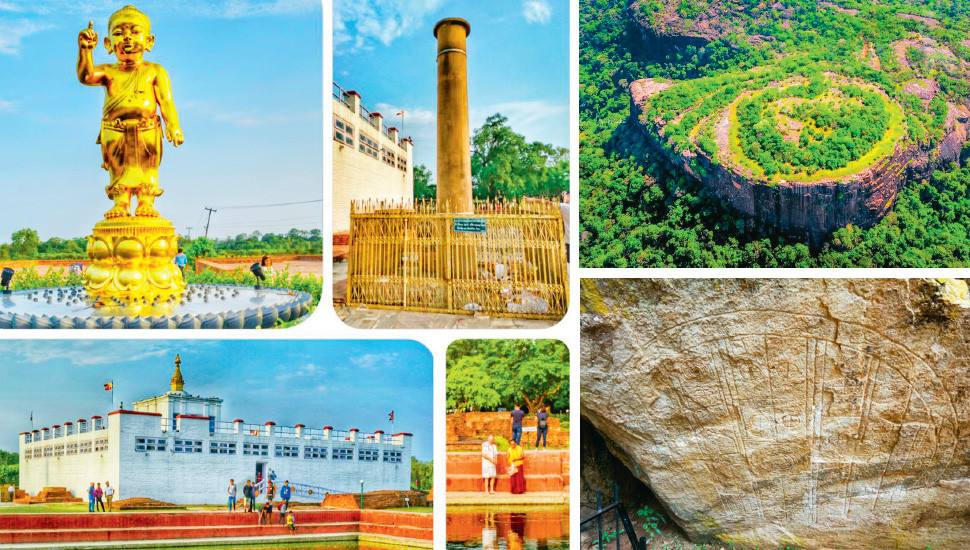Putting an end to Pseudo archaeology in Sri Lanka

Unscientific Twisting of the Truth
By Ama H.Vanniarachchy
Ceylon Today Heritage presented to you a series of articles about Pseudo archaeology over the last four weeks and its negative and possible disastrous impacts on Sri Lanka’s cultural heritage. We discussed many examples of pseudoarchaeology in Sri Lanka and presented evidence to say how these pseudo archaeology stories are mere fables and far from the truth. Among the many such stories is the story of Ravana, the story that Buddha was born in Sri Lanka, stories about Aliens communicating with ancient Sri Lankans, and there is a stargate in Sri Lanka, Sri Lanka is the centre of all civilizations, and that civilization spread to the world from Sri Lanka (including to the central and south America, to the Caspian sea area, to Assyria, etc) and that Adam was in Sri Lanka, etc, seems to be notably popular. With the advances in digital media, these fables were given a bigger and better platform and provided with a wider fan base.
While some spread these stories for monetary gains, some would do that for spreading racism and to spread a false sense of nationalism. Followers of these beliefs are doing so for many reasons as we have discussed in our previous four articles, mainly them being driven by a false sense of national pride and religious faith. Little do they know that they are digging their own grave.
In our previous articles, we have presented valid archaeological evidence, facts, theories, and arguments from the research work of acclaimed historians and archaeologists, national and international. Last week we presented to you a lengthy discussion we had with the British archaeologist professor Robin Coningham who has done extensive archaeological work in Nepal, including Lumbini and Tilaurakot.
Today, in our final segment we shall present to you the perspective of some of Sri Lanka’s leading and acclaimed scholars in History and Archaeology with regard to pseudoarchaeology.
Joining us in conversation, senior archaeologist professor emeritus T.G.Kulatunga said that the Ravana story has no historical or archaeological base and that the place names related to the Rama-Ravana story are all recently made names. He further said that such names have no historical background. The examples he stated are Ravana-Ella, Ravana Kotuwa, and Seetha Eliya.
The professor also said that the story behind Rumassala is also a recently fabricated fable and there is no scientific truth behind it.
Another example professor Kulatunga stated was that the stones people call Seetha Guli in Nuwara Eliya and Ravana Guli have no scientific basis at all. He said that in recent laboratory research conducted by Dr.Arjuna Thanthilage, it was confirmed that these Ravana Guli stones are not man-made but are naturally created stones.
Professor Kulatunga says that some scholars argue for the existence of an ancient Ravana age in Sri Lanka, before the arrival of Aryans, and they also posit the existence of a risi named Pulasti who was versed in medical science; however, there is no evidence to support this theory. He further explains this in his book Hero-Stone at Anuradhapura and Other Essays, where he argues that, except for the 17th-century Rajavaliya, 14th-century Kurunagala Vistaraya, 14th – 17th century written Kadaim poth (Books of Boundaries) and a few Ola leaves in the Colombo Museum that mentions a Sri Lankan king called Ravana yet no source before this period provides any reference to a Sri Lankan Ravana.
Professor Senerath Paranavitana argued that the Lankapura of the Ramayana, according to context, had been a place in South India, while H.A.P.Abeywardana, states that Lankapura in the Ramayana is an imaginary land and that there are no reasons to take it as Sri Lanka.
Senior professor Anura Manatunge, the Director-General of Archaeology, Department of Archaeology said that the point where things have gone wrong is that people consider fictional characters to be historical characters so they are now at a point where they are unable to differentiate between fiction and fact. Consequently, if one-day people consider King Kakille and Mahadanamuththa as historical figures, the public will expect future archaeologists to do archaeological research about these two fictional characters too. Therefore, Professor Manatunga emphasized the importance of understanding the difference between fictional characters and historical characters.
He further said that Ravana is clearly a fictional character and to date, there is no archaeological data discovered to prove his historical existence in Sri Lanka or India.
“To me the two characters Ravana and Kekille are similar”, he said. “Both are merely fables of kings that are popular in folklore or literature”.
These stories, events, characters, and places in literature and folklore are beyond the scientific discipline of archaeology, he said.
As professor Manatunga explained, the story of Buddha born in Sri Lanka is far more dangerous and vicious. It seems that certain groups and individuals are spreading this purposefully.
“It is very clear that there is no archaeological evidence in Sri Lanka to say that Buddha was born in Sri Lanka”, he emphasized.
Gautama Buddha was a historical figure who was born and lived in Northern India. His birthplace in Lumbini and other places where he lived are archaeologically proven and well preserved in present-day Nepal and India. Therefore, if these groups are claiming that he was born in Sri Lanka, the points they present and arguments they bring up are illogical and irrational, said the professor.
Answering a question he said that these myths which clearly come under pseudo archaeology will not do any damage to our cultural heritage if our people act wisely and sensible. He said that he believes that the majority of Sri Lankans are wise enough not to be misled by these myths, but it is only a minority who believes in these myths.
Professor Manatunga said that the Alien stories are also out of the realm of reality and are not scientific at all.
“Reconstructing the past should be done following logical theories and scientific facts. These Alien stories are just supernatural dreams some people have.”
He also said that those who understand the teachings of the Buddha will never go after such myths as they are illogical and being logical and led by facts is what Buddha always taught. Fables and myths are never encouraged within Buddhist philosophy, he concluded.
Rajakeeya Pandita ven. Missaka Kamalasiri thero said that as we have always reconstructed our past based on scientific theories and methods, our legacy has been honoured and cherished by the world. But if we keep encouraging and believing in pseudoarchaeology as it is happening now in Sri Lanka, our country will be mocked in front of the world and we will lose our credibility in international academia.
Senior Professor Prishanta Gunawardhene of the University of Kelaniya and the former DG of the Central Cultural Fund shared his views and experience in this regard. He has worked at Tilaurakot (ancient Kapilavastu) with the team co-led by professor Robin Coningham since 2014.
Tilaurakot is the ancient city of Kapilvastu where Prince Siddhartha spent his youth and today this ancient city is being explored and studied. As the professor explained, the antiquity of this site is being confirmed through C14 dating methods. The ancient rampart and many old buildings are being discovered within the small city boundaries and they are still in the process of identifying the buildings. Pottery and many other remains that were discovered through the excavations at the rampart are dated to the 6th century BCE.
Pilgrims of many Buddhist countries are now visiting Tilaurakot as it is an accepted and venerated sacred place where Prince Siddhartha spent his youth. It is a scientifically proven fact and a worldwide accepted fact that Lumbini is the birthplace of the Buddha.
The marker stone marking the exact birthplace of the Buddha is another solid evidence to prove Lumbini as the birthplace of the Buddha and not elsewhere, emphasized the professor.
“It is important that we look at all human races as human beings and not spread racism. Especially as archaeologists we should leave races and religions away and present the truth. Some of these pseudo archaeology stories encourage racism and that is bad,” concluded professor Gunawardena.
(In our last week’s article, professor Coningham explained in detail the archaeology at Lumbini and the significance of the Asokan pillar)
Professor Nandani Damayanthi Karunathilake, retired/former professor of the Department of History and Archaeology, University of Sri Jayewardenepura said that the Sri Lankan cultural heritage is on the verge of facing a possible great tragedy due to the rise of pseudoarchaeology. She emphasised that the Buddhist culture that we know today was reconstructed based on archaeological research and scientific data. But with the advance of pseudoarchaeology, it seems as if scientific archaeology is facing a threat.
“In this unfortunate situation, there are many things that we have to do and we have to act fast before it is too late. I would like to say a few things that we can do.”
The archaeological research work of archaeologists like Dr.Siran Deraniyagala, Dr. Senaka Bandaranayake, and Dr. Roland Silva should be more accessible to the public. There should be easy ways to access these books and articles and present-day scholars can write articles referring to these research and share them with the public. In today’s digital era anyone can write and upload anything on digital platforms. This is how many myths are spread. When a lie is repeated there is a tendency that they are accepted as the truth. Therefore, media companies should always report the truth and scientific facts when it comes to the country’s history and archaeology. Scholars in history and archaeology and Buddhist monks can play a significant role in the battle against pseudoarchaeology. There are some Buddhist monks and academics who have already undertaken this responsibility and we must appreciate that. Schools, universities, and pirivenas should also take the lead in bringing the country’s true history to the spotlight. They can conduct research on these specific topics related to pseudoarchaeology. The school syllabus (history, literature, and arts education) should focus on educating children about the country’s true history and archaeology. Books, articles, and other forms of media that encourage and entertain pseudo archaeological myths should undergo some form of restriction or monitoring.
“I believe that we should not take the rise of these myths as something light. We have to act fast because our history matters to build a stronger future”, she concluded.
When we contacted the public group Mithyawata Erehiwa, a group of young enthusiastic scholars and history lovers, led by senior archaeologists said that the public should be wise and analytical when learning history and should not believe in fables. People should be rational and logical and should not be driven by emotions.
They also insisted that academics should come forward and make the accurate and scientifically correct data accessible to the public. It is also the duty of academics to let the public know the correct facts about the country’s history. The group also emphasised that the media has a bigger role to play in putting an end to pseudoarchaeology.
Uncategorized, Ama H.Vanniarachchy, pseudoarchaeology, Sri Lankan archaeology, SRI LANKAN HISTORY
